When I visited Gloucester Docks, I found myself in a spot where history, industry, and daily life all seem to overlap. The area’s full of red-brick Victorian warehouses—most now buzzing with shops, cafes, and museums. Every step I took, I picked up on echoes of the past, but there’s this new, lively vibe by the water too.
Walking around Gloucester Docks, I checked out museums like the National Waterways Museum, wandered along lively quays, and saw how the old docks have turned into a favorite hangout for locals and visitors alike. The stories behind the historic buildings pulled me in, and I loved pausing to watch boats in the marina. There’s something about the mix of old and new here that just works.

As I explored Gloucester’s restored docklands, I realized there’s a lot more going on than I expected. Every corner seemed to offer a surprise—guided walks, waterfront restaurants, and little spots to relax or people-watch. It’s a place that rewards a bit of curiosity.
The Historic Significance of Gloucester Docks
Gloucester Docks is one of those rare places where the city’s maritime history feels real and close at hand. Strolling along the water, I saw how the port’s origins, its imposing Victorian warehouses, and deep trade roots shaped not just the docks, but all of Gloucester.
Origins as an Inland Port
Gloucester Docks started out as the UK’s most inland customs port. Ships came up the River Severn, turning the city into a key trade link far from the coast.
That distance from the sea made Gloucester a magnet for merchants. The docks made it easy to move cargo—timber, grain, you name it—between ships and canals. It gave Gloucester a real advantage over other towns.
I learned that the docks helped the city boom in the 19th century. Storage and customs jobs kept goods flowing, and people flocked here for work. The location made sure Gloucester stayed connected to both national and international trade.
Victorian Warehouses and Architectural Features
Most of the iconic warehouses lining the docks date back to the Victorian era. As I walked past the red-brick buildings, I spotted names like Victoria, North, Albert, Britannia, Lock, and Llanthony Warehouse.
They built these warehouses to last—tall, sturdy, and designed for serious storage. Thick walls and big doors made loading and unloading a breeze for dock workers.

Today, many warehouses have found new life as museums, shops, or apartments. Their classic features remain, showing off some of the best Victorian dockside architecture around. This mix of history and careful restoration gives the place a special feel.
Warehouse Table
| Name | Built | Original Use |
|---|---|---|
| Victoria Warehouse | 1849 | Grain storage |
| North Warehouse | 1826 | General goods |
| Albert Warehouse | 1847 | Grain |
| Britannia Warehouse | 1861 | Timber |
| Lock Warehouse | 1834 | Storage/Offices |
| Llanthony Warehouse | 1873 | Various imports |
19th Century Trade and Commerce
During the 1800s, trade fueled Gloucester Docks. Ships brought in goods from all over—timber from North America, grain from Europe.
The docks buzzed with special equipment like cranes and weighbridges, making work faster. Customs officers checked and taxed everything before it headed inland, which filled the government’s pockets and made Gloucester a key customs port.
Trade brought money and jobs, shaping the city’s character. Even now, you can spot the traditions and heritage that grew out of that busy era.
Exploring the Maritime Museums
Gloucester Docks is packed with museums that make the city’s maritime and military history come alive. Old warehouses now hold spaces where you can wander through the past, check out preserved boats, and get hands-on with real artifacts.
Gloucester Waterways Museum
When I stepped into the Gloucester Waterways Museum, towering Victorian warehouses greeted me. These old spaces now house interactive exhibits about Britain’s canals and rivers. The museum sits in the old Llanthony Warehouse, which once stored goods from around the globe. That history lingers in the air.
Inside, I found models, maps, and stories about ships and waterways. I climbed aboard heritage boats and got a real sense of canal life. Big windows flood the museum with light, making it a pleasant spot to linger. There’s a small café and a shop near the entrance.

Some exhibits focus on how canals changed trade and daily routine in Gloucester. I saw tools and photos from workers who kept the waterways open. If you’re interested in boats or local history, this place is a must.
Soldiers of Gloucestershire Museum
Not far from the docks, the Soldiers of Gloucestershire Museum tells the story of the county’s army regiments. I found it fascinating to see how local soldiers shaped history, both at home and abroad. The displays cover over 300 years, stretching from the 1600s to today.
Uniforms, medals, weapons, and personal keepsakes fill the rooms. Some exhibits use video and sound to bring big battles—and daily army life—to life. There’s even a recreated trench that really sticks with you.
The museum also shares stories about women, families, and even animals connected to the regiments. Staff offer guided tours and answer questions. It’s a thoughtful, well-curated collection that shows a different side of Gloucester’s past.
National Waterways Museum Exhibits
The National Waterways Museum features hands-on exhibits about the growth of British canals and Gloucester’s key role as an inland port. I started with displays on canal engineering—old tools, valves, and engine parts that show how things worked behind the scenes.
In the Waterside Gallery, I wandered among historic boats, some lovingly restored, others left as they were. I stepped inside narrowboats and barges to see how families lived and worked on board. Touch screens and audio guides explained the stories and challenges faced by different crews.
There’s also a focus on canal wildlife. Kids can try out interactive activities, like operating a simulated lock. Temporary exhibits rotate throughout the year, so there’s usually something new. The museum does a great job making history and technology feel up-close and personal.
A Revitalized Waterfront Experience
The Gloucester Docks waterfront stands out for its mix of restaurants, shops, and a lively arts scene. Historic warehouses now house a modern hub for food, shopping, and entertainment.
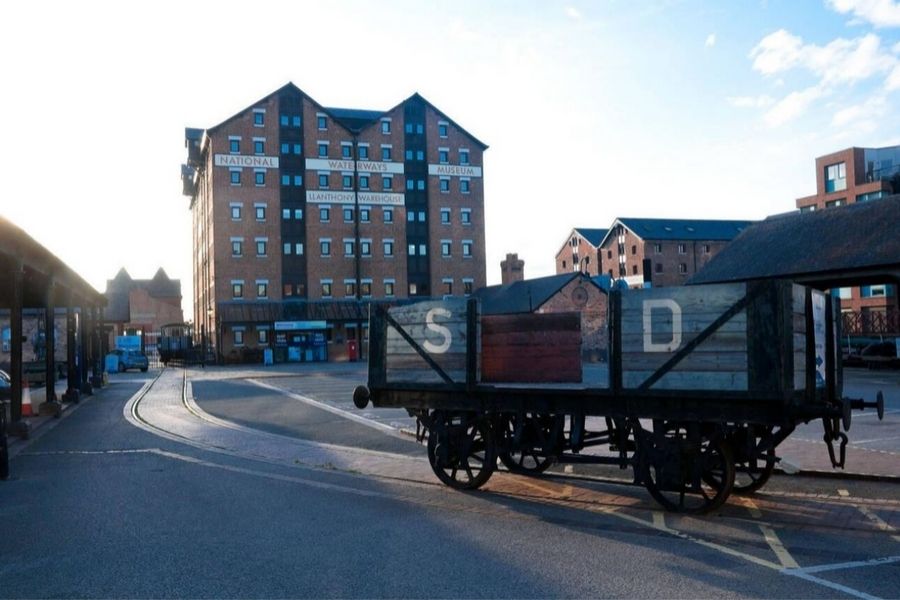
Restaurants and Local Shops
Along the water, I found plenty of places to eat. Greek on the Docks quickly became a favorite, serving Mediterranean dishes with a view of boats drifting by. Most spots offer outdoor seating, so you can soak up the sights and sounds while you eat.
Local shops fill the restored warehouses, selling gifts, books, and art. I spotted bakeries and small food stalls tucked between bigger cafes and restaurants.
Quick bites are easy to find—sandwiches, pizza, and plenty of family-friendly menus. Whether you want a sit-down meal or just a coffee, there’s always a spot open. Prices feel fair for the setting, and most places have a relaxed, friendly vibe.
Gloucester Quays Designer Outlet
Gloucester Quays Designer Outlet draws a crowd. The modern shopping center fits in surprisingly well with the historic surroundings. With more than 60 stores, I browsed outlets for brands like Nike, Levis, and Calvin Klein.
Discounts run from 30% to 60% off, and the range surprised me—clothes, kitchenware, even home goods. Wide walkways made shopping easy, even on busy weekends. Shops stay open late during holidays.
Inside, you’ll find snack bars and ice-cream stands, plus plenty of places to rest. Clean restrooms and free Wi-Fi made longer shopping trips more comfortable. I liked being able to check store info on my phone as I went.
Arts, Events, and Nightlife
It’s not just about shopping and eating. I found art galleries and pop-up exhibitions near Gloucester Quays. The docks host outdoor events—live music, street food festivals, seasonal markets—especially when the weather’s good.
Nightlife has picked up in recent years. Bars and cozy pubs fill up in the evenings, many offering live music or quizzes. Some restaurants turn into lively spots with music after dinner. The old warehouses now glow after dark, making evening walks along the quayside pretty inviting.
Event schedules are posted around the docks and online. I’d check ahead—there’s usually something new happening. The mix of arts and entertainment keeps the docks buzzing well into the night.
Waterways and Iconic Structures
Gloucester Docks owes its character to the waterways and the striking architecture that’s still standing. From busy basins to historic bridges, every site tells a bit of the city’s maritime past.
Main Basin and Victoria Basin
I started out at the Main Basin, which has always been the docks’ heart. Finished in the early 1800s, the Main Basin once teemed with cargo ships, barges, and narrowboats. Its deep, wide waters allowed big vessels to reach Gloucester from the River Severn.
Victoria Basin sits nearby, built to handle even more traffic as trade boomed. Today, both basins are lined with old warehouses that have been carefully preserved.
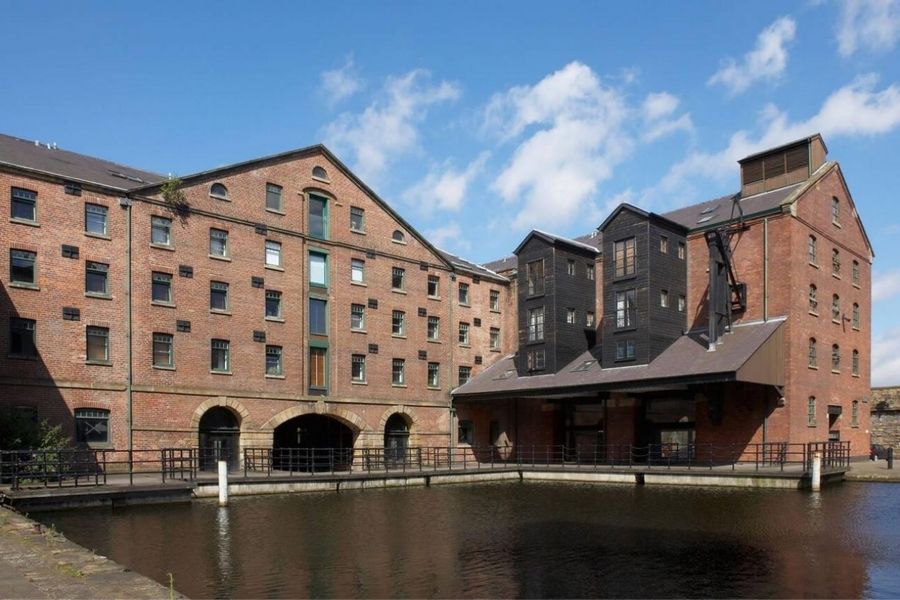
Many of those warehouses now hold cafes, apartments, or shops. The brickwork and iron moorings still show off the area’s history. Boats still tie up here, and it’s easy to imagine when the place was packed with tall ships and busy dockworkers.
Llanthony Bridge and Waterways
I wandered toward Llanthony Bridge, one of the docks’ best-known sights. This working swing bridge, named for Llanthony Priory, links both sides of the quayside. I watched it swing open for a tall vessel—proof these waterways are still very much alive.
Both pedestrians and cars use Llanthony Bridge, making it a key crossing over the canal. The heavy iron and big gears add real character to the scene. Along this stretch, ducks and swans mingle with modern boats—a reminder of how industry and nature mix here.
The Barge Arm is nearby, a quieter bit of water often filled with pleasure boats and smaller working craft. Historical signs share stories about dockworkers who once lived and worked here.
Gloucester to Sharpness Canal
The Gloucester to Sharpness Canal changed everything for the city. When it opened in the 1820s, it gave Gloucester a direct link to the docks at Sharpness, skipping the River Severn’s dangerous bends and tides.
I followed the canal for a bit, noticing its straight, deep water. It’s about 16 miles long and was built wide enough for the biggest ships of its time. The canal doesn’t just connect to Sharpness—it links Gloucester to places like Tewkesbury and beyond, tying the docks into a huge network.
Today, pleasure boats and narrowboats glide along, but you can still spot stone mile markers and old wharf remains. The calm water reflects both the area’s history and the life that keeps moving through Gloucester’s docklands.
Events, Festivals, and Guided Tours
Gloucester Docks buzzes with activity all year. Ships, boat rides, and historical walking tours fill the area with energy and a sense of discovery.
Gloucester Tall Ships Festival
The Gloucester Tall Ships Festival stands out as one of the docks’ most exciting annual events. When I visited, I watched massive tall ships—some replicas, others true historic vessels—sail in and tie up along the quays.
Climbing aboard a few of these ships felt like stepping into another era. Crew members welcomed questions about navigation or daily life at sea, and they seemed genuinely eager to share stories.
Live demonstrations and music kept the festival lively and unpredictable. Actors in Victorian sailor costumes mingled with the crowds, and I caught part of a performance inspired by “Upstairs Downstairs.”
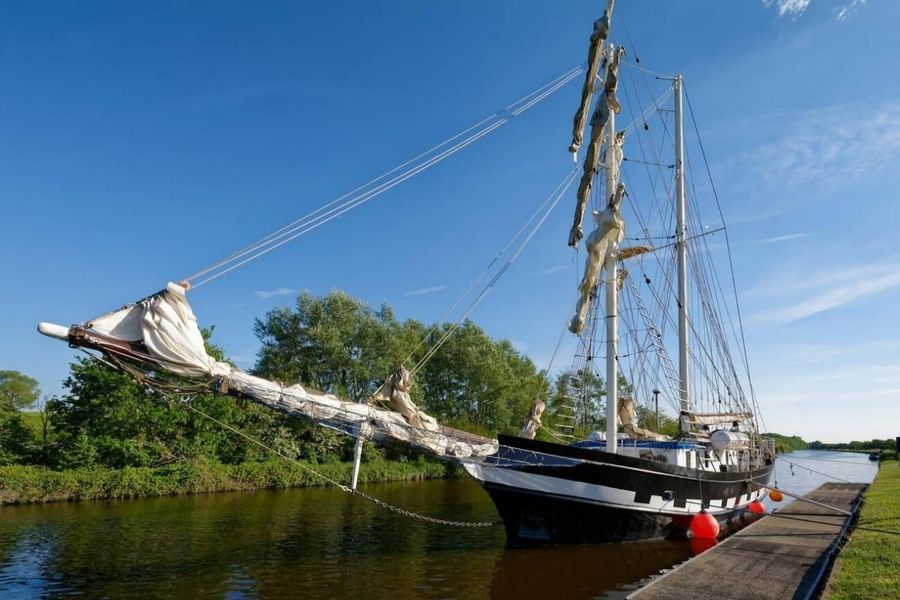
Street food stalls tempted me with local flavors, while craft markets and exhibitions dug into Gloucester’s maritime heritage. Families flocked to pirate treasure hunts and storytelling sessions, which made the whole place buzz with energy.
Boat Trips and Pleasure Cruises
Boat trips give you a fresh perspective on Gloucester Docks. I hopped on the Queen Boadicea II, a boat that actually took part in the Dunkirk evacuations during World War II. That history alone gave the cruise an extra layer of meaning.
Trips vary—some last just a short while, gliding along the canal, while others turn into themed adventures inspired by stories like David Macaulay’s “Amazing Grace” or “Alice Through the Looking Glass.”
Floating down the Gloucester & Sharpness Canal, I slowed down and took in the old Victorian warehouses and the revived waterfront. Boats seem to depart regularly during the tourist season, though it’s always worth checking the main docks area or local websites for updated schedules.
For something different, evening cruises sometimes feature live music or a guide sharing quirky bits of local history.
Guided Tour Experiences
Guided tours really brought the docks’ history alive for me. I joined a walking tour led by a Gloucester Civic Trust guide, and it was anything but dry.
Tours usually start from St Michael’s Tower. The guide painted a vivid picture of the docks’ Victorian origins, the hustle of trading timber and grain, and the characters who shaped the area.
I picked up stories and details you just won’t find in guidebooks. The guides pointed out architectural oddities, explained how the warehouses changed over time, and introduced us to some colorful local legends.
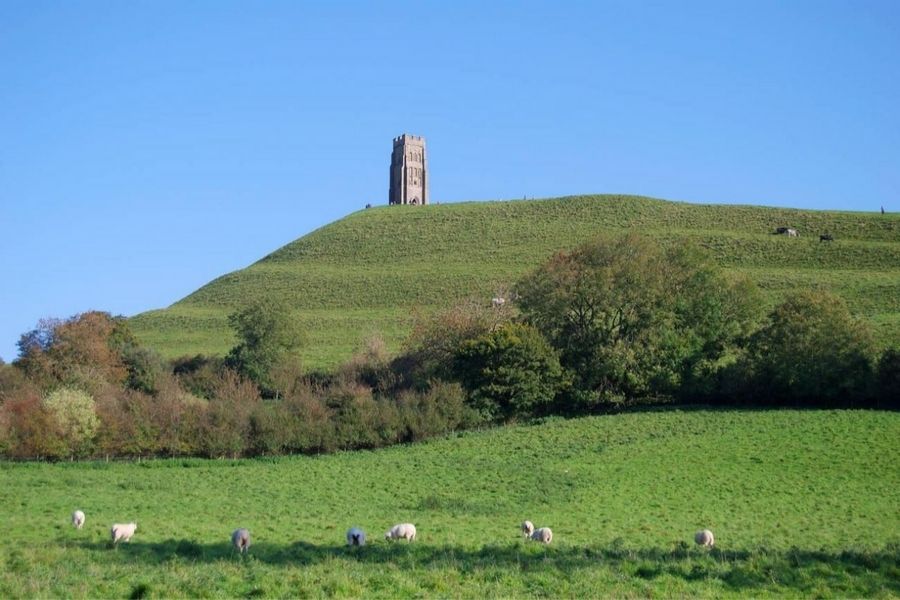
Some tours focused on archaeological discoveries, and occasionally, we got to peek at special exhibits that aren’t usually open to the public.
Tip: If you want a spot on a guided tour—especially in summer—book ahead.
Practical Tips for Visiting Gloucester Docks
Getting to Gloucester Docks isn’t complicated, and the place is surprisingly visitor-friendly. They’ve kept the facilities in good shape, and most attractions are just a short walk apart.
Getting There: Railways, Motorways, and Parking
Reaching Gloucester Docks felt simple, whether I came by car, train, or bus. The train station sits about a ten-minute walk from the docks, with regular services from Bristol, Cardiff, Birmingham, and London.
If you drive, the M5 motorway makes things straightforward. From Junction 11a or 12, just follow signs to the city centre. Several public car parks are close—Gloucester Quays multi-storey and North Warehouse car park both offer accessible bays and decent signage.
Parking fills up quickly on weekends or during big events, so I’d suggest arriving early or using park and ride if you want to avoid circling for a spot. Buses also stop near Gloucester Quays and the city centre, which makes things easier.
Visitor Facilities and Accessibility
Facilities around the docks are modern and generally easy to navigate. Public toilets—including accessible and baby-changing options—sit close to the main visitor spots and the designer outlet.
Most restaurants, the National Waterways Museum, and cafés have step-free entry. I appreciated the wide, smooth walkways by the old warehouses, where sturdy cast-iron columns and original wooden floors add some character.
Paths make it easy for wheelchairs and prams. Clear signs point the way to highlights like the Sula lightship and Mariner’s Chapel.
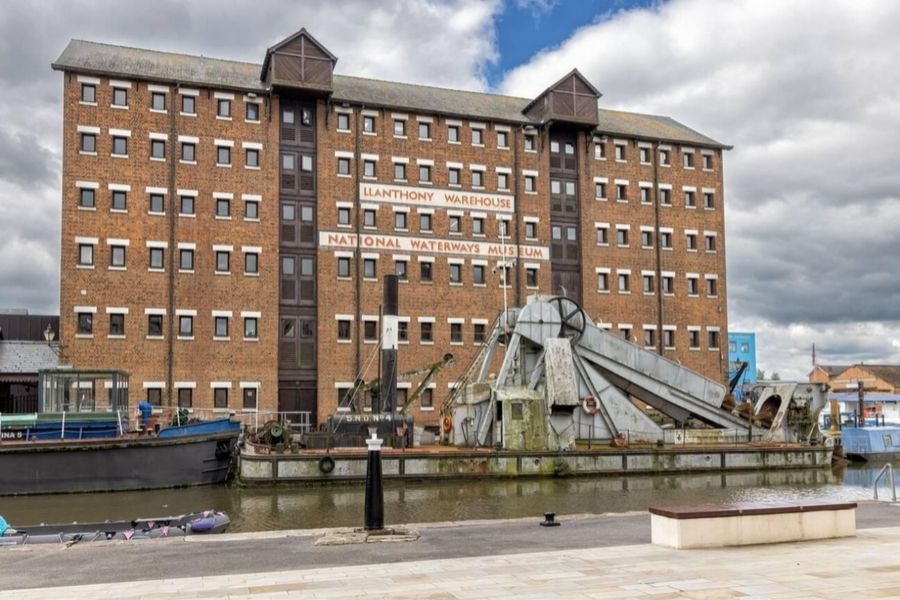
If you need a break, benches line the waterfront. Staff at museums and shops didn’t hesitate to help with directions or answer questions about the docks’ slate roofs or customs history.
Nearby Attractions and City Centre
You’ll find the docks right beside Gloucester city centre, so hopping between the two is a breeze. I love wandering the historic docks—there’s always something going on, from quirky independent shops to bustling cafés and restaurants. And the views? You get a mix of yachts bobbing in the water, Gloucester Lock, and the old tramroad peeking through.
If you stroll just a bit, you’ll bump into the Llanthony Secunda Priory or maybe the Mariner’s Chapel. For anyone curious about the area’s past, the museums here really bring to life the story of England’s most inland port. It’s wild to think about all the ships and narrowboats that came through from Wales and beyond.
When I need a shopping fix, Gloucester Quays Designer Outlet has me covered. The city centre itself? It’s packed with high street stores, plenty of places to grab a bite, and of course, that stunning cathedral—all just a short 15-minute walk away.

